12 Best Enterprise Security Software Solutions for 2025
- Marketing Team
- Nov 11
- 19 min read
Updated: Nov 12
In 2025, selecting the best enterprise security software is more than a technical decision; it's a strategic imperative for protecting your organization from the inside out. Decision-makers in Compliance, Risk, and HR face a landscape where the costliest threats often originate from the human factor, a gap that conventional tools fail to address. Traditional security stacks, heavily focused on external cyber threats, leave organizations vulnerable to internal risks.
Reactive investigations and surveillance-based monitoring are not only expensive and inefficient but also introduce significant legal and ethical liabilities, particularly under regulations like the EPPA. The new standard for enterprise security focuses on proactive, non-intrusive prevention that respects employee privacy. This guide moves beyond conventional cybersecurity to explore 12 leading solutions, highlighting platforms that empower organizations to ethically manage internal risks, strengthen governance, and secure their reputation before an incident occurs. Moving beyond outdated security models requires adopting modern approaches such as incorporating actionable DevOps security best practices into every stage of development and operations.
This resource provides a direct, in-depth comparison of the top enterprise security software. We will analyze each tool's approach to risk, focusing on business impact and the crucial shift from reactive forensics to AI-driven, preventive risk management. For each platform, you'll find a clear breakdown of its core function, ideal use cases, implementation considerations, and an honest look at its limitations. With direct links and screenshots, you'll gain the insights needed to choose a solution that aligns with a modern, ethical, and proactive security posture.
1. Logical Commander Software Ltd.
Logical Commander emerges as a premier choice in our lineup of the best enterprise security software, distinguishing itself as the new standard in proactive, AI-driven prevention of human-factor risks. Its unified E-Commander platform is engineered for organizations in regulated industries that prioritize ethical, EPPA-aligned governance and seek to prevent internal threats, rather than suffer the high cost of reactive investigations. Unlike cyber tools that focus on external attacks, this solution addresses the 95% of risk that starts and ends with humans, providing actionable intelligence to mitigate potential issues related to compliance violations and human capital risks before they escalate into financial or reputational crises.
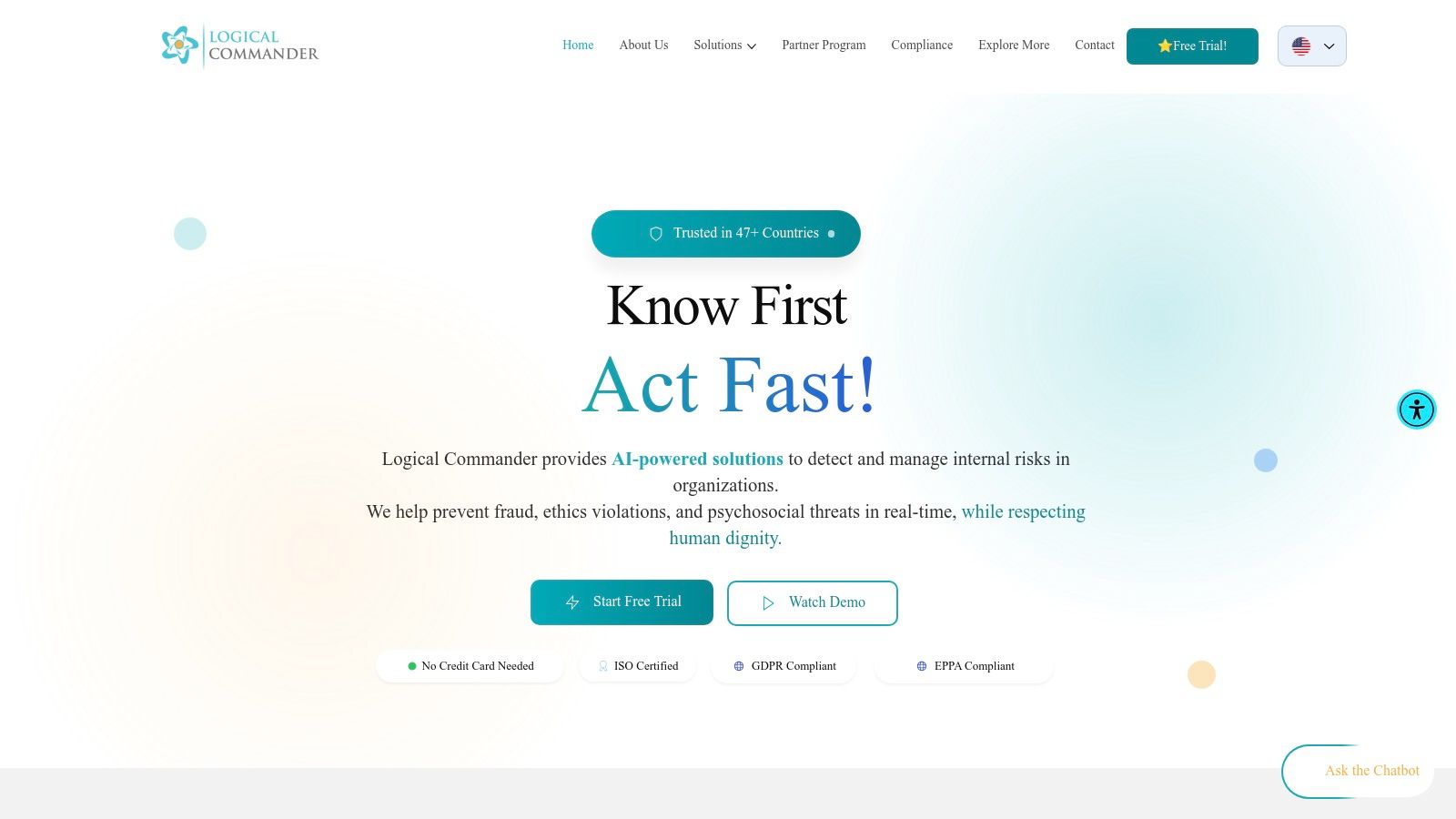
What truly sets Logical Commander apart as the new standard is its non-intrusive, privacy-first methodology. The platform is explicitly designed to be EPPA-compliant, avoiding any form of prohibited surveillance, lie detection, or coercive analysis while respecting employee dignity. This ethical framework makes it a standout option for HR, legal, and compliance leaders who must manage internal risk without creating a culture of distrust—a common failure of traditional, invasive security tools. Its modular design, featuring specialized tools like Risk-HR for hiring integrity, allows it to scale from small teams to global enterprises. For B2B SaaS companies, the PartnerLC program offers a unique opportunity to integrate this next-generation risk management solution.
Key Strengths and Use Cases
Proactive Threat Prevention: Instead of waiting for an incident, the platform identifies early warning signals related to human-factor risks. This allows security and HR teams to intervene constructively, preventing massive business impact and liability associated with costly investigations and damages.
Cross-Functional Risk Management: Logical Commander centralizes risk intelligence for multiple departments. A Chief Risk Officer can get a holistic view of organizational threats, an HR leader can improve hiring integrity, and a compliance officer can ensure governance standards are met, all within a unified system.
Global Compliance and Security: With ISO 27001/27701 certification and adherence to GDPR and CPRA, the platform is built for enterprises operating in complex regulatory environments. Its deployment in over 47 countries demonstrates its capability to handle diverse compliance needs.
Immediate and Measurable ROI: The platform is designed for immediate impact. A customer testimonial reported a 45% reduction in turnover in high-security roles, showcasing a direct operational and financial benefit from its first activation without a lengthy rollout period.
Considerations
The primary consideration is that pricing is not publicly available, requiring direct engagement for an enterprise-level quote. Furthermore, while the AI provides powerful insights, its effectiveness is maximized when integrated into well-defined internal processes, requiring a commitment to organizational change management to act on the intelligence it provides.
Best for: Organizations seeking an ethical, EPPA-compliant, and proactive approach to managing internal human-factor risks across HR, security, legal, and compliance functions.
2. AWS Marketplace
For enterprises deeply integrated into the Amazon Web Services ecosystem, the AWS Marketplace serves as a streamlined hub for discovering, procuring, and deploying a vast array of the best enterprise security software. Rather than navigating separate vendor procurement cycles, organizations can leverage their existing AWS relationship to centralize billing and simplify the acquisition of critical security tools. This approach is particularly effective for managing human-factor risk and internal threats by providing quick access to specialized solutions.
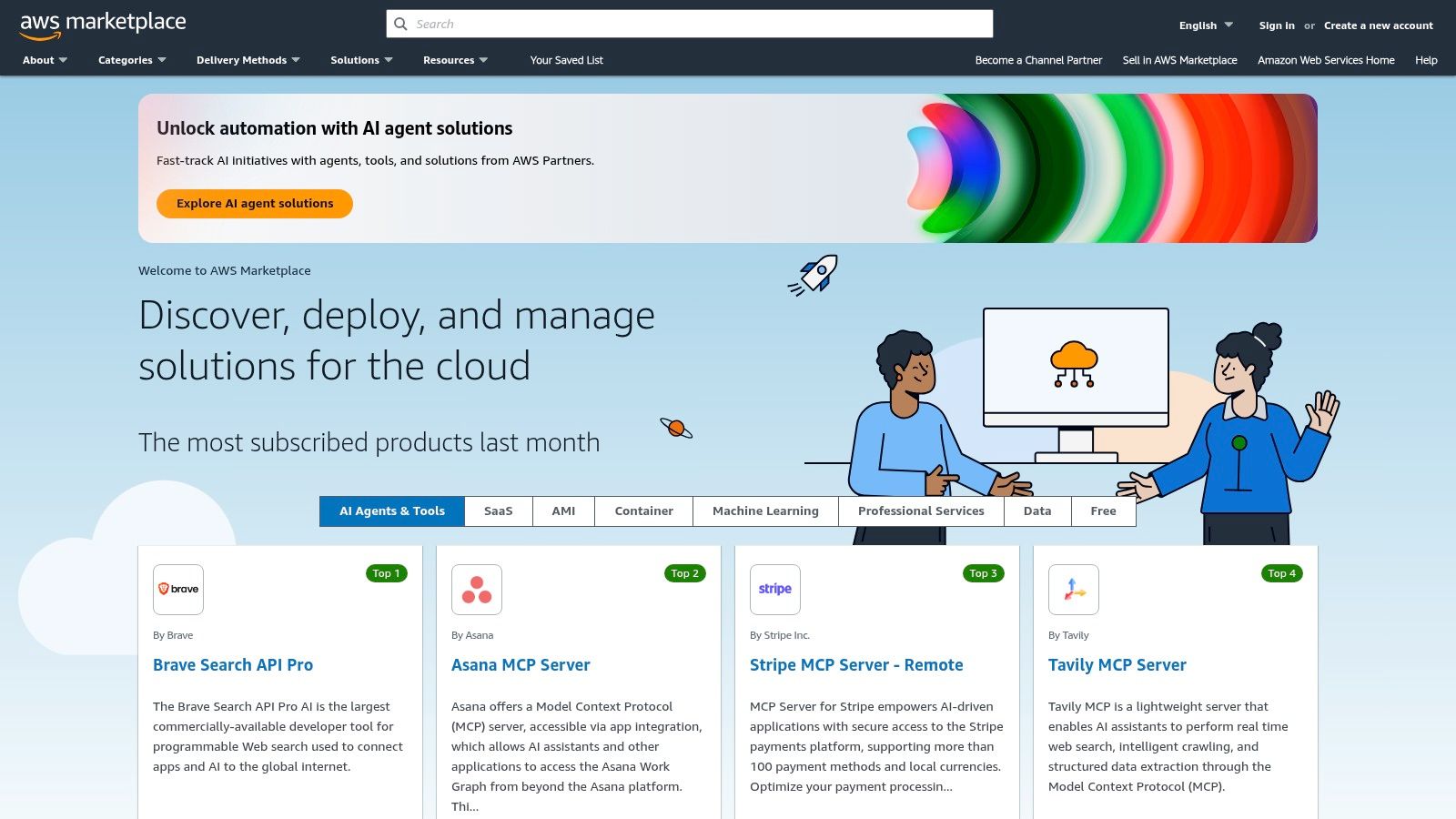
The platform stands out by integrating procurement directly into the cloud governance framework. Features like AWS Vendor Insights provide continuously updated security and compliance information, drastically reducing the time legal and risk teams spend on third-party vendor assessments. This allows for faster deployment of ethical risk management tools needed to protect sensitive corporate assets. The marketplace offers flexible billing, including pay-as-you-go, annual subscriptions, and private offers, enabling financial predictability.
However, a key consideration is that the total cost of ownership includes both the software subscription and any underlying AWS infrastructure it consumes, which can complicate budgeting. Additionally, while many listings are transparent, some require direct contact with the vendor for custom pricing. Despite these points, its ability to consolidate procurement and governance makes AWS Marketplace a strategic resource for deploying comprehensive, EPPA-compliant platform solutions efficiently.
Key Features & Offerings:
Extensive Security Catalog: Thousands of listings from network security to identity management and AI human risk mitigation tools.
Integrated Billing: Consolidates software charges onto a single AWS bill, simplifying expense management for finance teams.
AWS Vendor Insights: Streamlines third-party risk assessments with access to pre-vetted compliance and security data.
Flexible Procurement: Supports various models including private offers for custom terms and enterprise contracts.
Website: https://aws.amazon.com/marketplace
3. Microsoft Azure Marketplace (Security)
For enterprises committed to the Microsoft ecosystem, the Azure Marketplace is an essential destination for acquiring the best enterprise security software. It allows organizations to procure and deploy security solutions directly within their Azure environment, streamlining management and consolidating billing. This is particularly beneficial for addressing human-factor risks and internal threats, as it provides a centralized platform for purchasing and deploying specialized tools for ethical risk management and threat protection.

The marketplace excels through its deep integration with Azure subscriptions and cost management tools, offering a seamless procurement experience. Its Private Marketplace feature enables tenant-level governance, allowing enterprises to create a curated catalog of approved solutions, thereby controlling software acquisition and ensuring compliance. This controlled environment simplifies the adoption of EPPA-compliant platform solutions designed for proactive risk prevention. Procurement flexibility is a key advantage, with options for private offers, custom contracts, and various SaaS payment plans.
However, users must ensure they have the correct Azure roles and billing configurations to transact, which can present an initial hurdle. Furthermore, pricing transparency can vary significantly between publishers, sometimes requiring direct negotiation for enterprise-level terms. Despite these considerations, its native integration and robust governance controls make the Azure Marketplace a powerful resource for enterprises seeking to efficiently deploy a comprehensive security posture.
Key Features & Offerings:
Large Security Catalog: A broad selection of solutions covering threat protection, Identity and Access Management (IAM), and governance.
Native Azure Integration: Seamlessly connects with existing Azure subscriptions, billing, and cost management services.
Private Marketplace: Provides tenant-level governance to control and curate software purchasing across the organization.
Flexible Procurement: Supports private offers, multi-year contracts, and various SaaS plans (per-user, metered, annual).
4. Google Cloud Marketplace + Security Command Center (SCC)
For organizations building on Google Cloud, the combination of its Marketplace and native Security Command Center (SCC) offers a powerful, integrated approach to security procurement and operations. This platform allows enterprises to discover, purchase, and deploy some of the best enterprise security software directly into their environment. This unified ecosystem is ideal for managing human-factor risks by centralizing security findings from both Google Cloud services and third-party tools into a single pane of glass.

The key differentiator is how SCC acts as a central hub for posture management and threat detection, especially with its Enterprise tier that extends curated detections to AWS and Azure. This creates a multi-cloud Cloud Native Application Protection Platform (CNAPP) where third-party solutions, such as AI human risk mitigation tools, can feed their findings directly into SCC. This integration streamlines the entire security architecture, consolidating alerts and simplifying response workflows. The Marketplace supports this with features like Private Marketplace for governance and consolidated billing through an existing Google Cloud account.
However, the SCC Enterprise tier is an organization-level commitment, which may not suit all deployment models. Additionally, some specialized security software listings on the marketplace require direct sales engagement for custom pricing, slightly hindering the self-service model. Despite this, the tight integration between procurement and a unified security command center makes this a highly effective platform for building a comprehensive, EPPA-compliant security posture.
Key Features & Offerings:
Integrated Security Hub: Security Command Center (SCC) centralizes findings from Google Cloud services and partner solutions.
Multi-Cloud CNAPP: The SCC Enterprise tier provides curated threat detection and posture management across Google Cloud, AWS, and Azure.
Unified Procurement: Consolidates software purchases onto a single Google Cloud bill and offers private offers for custom contracts.
Extensive Partner Integrations: A robust ecosystem of security vendors whose tools feed directly into SCC for streamlined operations.
Website: https://cloud.google.com/marketplace
5. CrowdStrike (Falcon platform)
CrowdStrike’s Falcon platform is a recognized leader in the best enterprise security software category, delivering a cloud-native solution for endpoint and identity protection. The platform excels at stopping breaches through a combination of next-generation antivirus, endpoint detection and response (EDR), and managed threat hunting. Its unified, lightweight agent simplifies deployment across Windows, Mac, and Linux environments, minimizing performance impact while providing deep visibility into endpoint activity to counter human-factor risks.
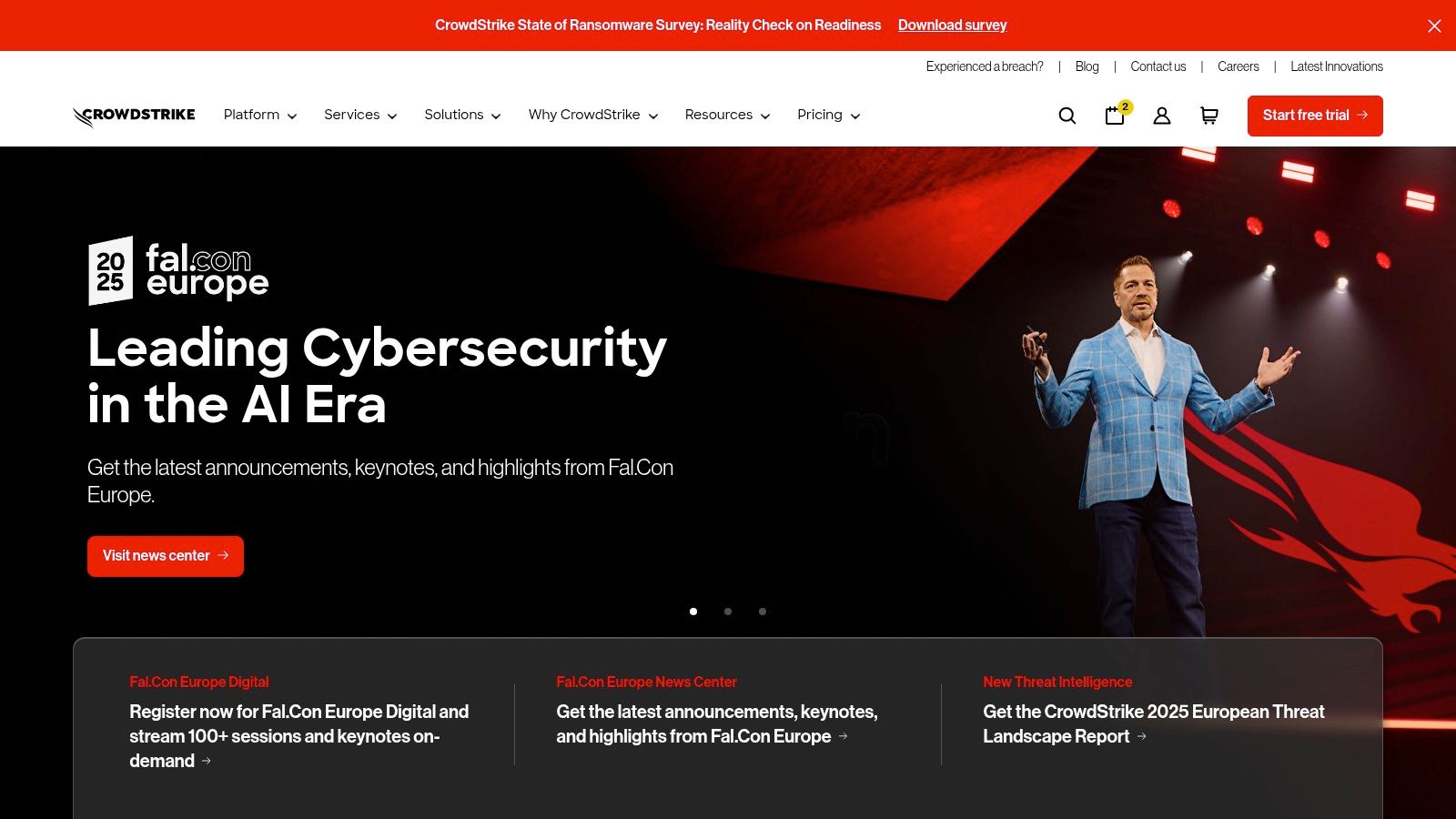
The platform stands out by offering transparent, per-device pricing for select bundles and a 15-day free trial, allowing organizations to evaluate its core capabilities quickly. This self-service approach is unique in a market often dominated by lengthy sales cycles. During the trial, users can explore an app-store-style marketplace to add modules like firewall management or device control, tailoring the solution to specific ethical risk management needs. For more details on its capabilities, you can explore information about insider threat detection tools and their role in a modern security stack.
However, while initial access is straightforward, enterprise-scale packages with advanced features like threat intelligence or managed detection and response (MDR) typically require direct engagement with the sales team for custom quotes. Furthermore, most bundles are billed annually, which may not suit organizations preferring monthly operational expenditures. Despite this, CrowdStrike’s powerful protection, ease of use, and strong industry reputation make it a top contender for securing the modern enterprise.
Key Features & Offerings:
Cloud-Native EDR/XDR: Provides a single lightweight agent for endpoint prevention, detection, and response across all major operating systems.
Modular Platform: Allows organizations to add capabilities like identity protection, device control, and managed threat hunting as needed.
Transparent Trials & Pricing: Offers a 15-day free trial and publicly posted pricing for certain endpoint protection bundles.
Threat Graph Engine: Utilizes AI and behavioral analytics to correlate trillions of security events for real-time threat detection and prevention.
Website: https://www.crowdstrike.com
6. SentinelOne (Singularity Platform)
For organizations prioritizing autonomous threat detection and response, SentinelOne's Singularity Platform offers a powerful, AI-driven solution. It provides unified endpoint (EDR), cloud, and identity security (XDR) to defend against sophisticated attacks across the entire enterprise estate. This platform is distinguished by its strong emphasis on automation, which helps security teams mitigate human-factor risk by rapidly containing threats without manual intervention, making it a top contender for the best enterprise security software.
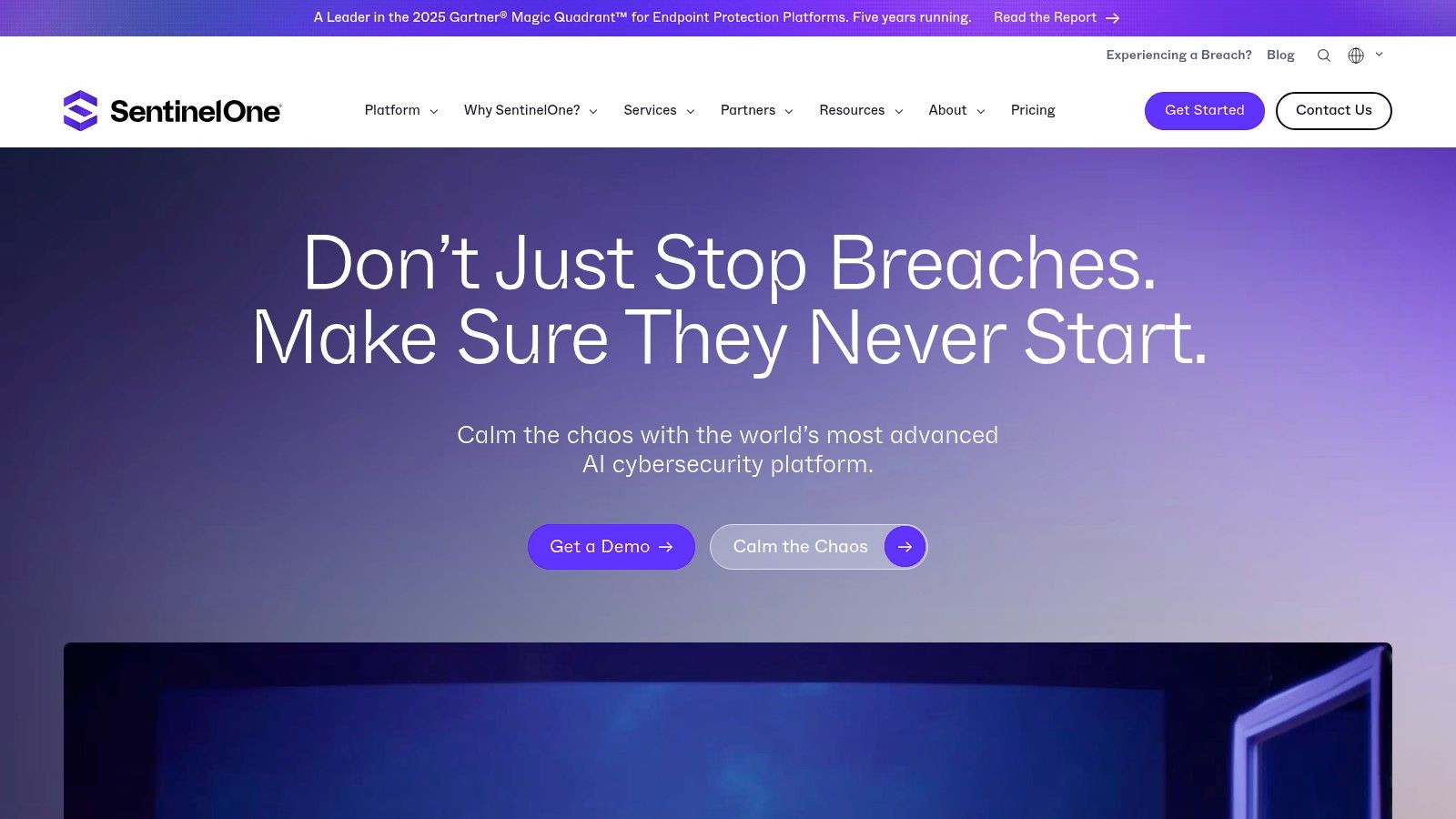
SentinelOne stands out with its transparent, multi-tiered pricing model published directly on its website, a rarity in the enterprise security space. This allows for clearer initial budget planning for endpoint protection. The platform's AI assistant and automated response capabilities are designed to reduce analyst workload and accelerate incident resolution, directly supporting ethical risk management by minimizing dwell time for threats. For larger organizations, the Flex program offers a consumption-based licensing model, aligning security spend with actual usage for greater financial efficiency.
However, while initial tiers are clearly priced, the most comprehensive Enterprise package requires direct sales contact for a custom quote. Additionally, the final cost can increase significantly when factoring in optional add-ons like extended data retention and managed threat hunting services. Despite this, SentinelOne's combination of powerful AI-driven automation and pricing transparency for core packages makes it a strategic choice for proactive, EPPA-compliant internal threat detection and response.
Key Features & Offerings:
Autonomous EDR/XDR: AI-powered detection and response across endpoints, cloud workloads, and identity platforms.
Transparent Tiered Pricing: Published annual, per-endpoint pricing for Core, Control, and Complete packages simplifies procurement.
Flex Licensing Program: A consumption-style model that allows enterprises to align security costs with actual resource usage.
Automated Response: Patented Storyline technology automatically remediates threats and reverses unauthorized changes.
Website: https://www.sentinelone.com
7. Palo Alto Networks (Cortex/Prisma/Strata)
Palo Alto Networks offers a comprehensive, full-stack security portfolio that addresses needs from the network edge to the cloud and the security operations center (SOC). This integrated approach makes it one of the best enterprise security software platforms for organizations seeking to consolidate vendors and unify their defense-in-depth strategy. Their ecosystem is segmented into Strata for network security, Prisma for cloud security, and Cortex for advanced detection, response, and automation, covering a wide spectrum of internal and external threats.

The platform’s strength lies in its interconnected architecture. For example, Cortex XSOAR automates complex workflows, which is crucial for building a robust security incident response plan. Enterprises can deploy VM-Series virtual firewalls directly from major cloud marketplaces like AWS and Azure, simplifying procurement and enabling consistent policy enforcement across hybrid environments. This flexibility allows security teams to deploy sophisticated controls quickly to protect corporate data and manage human-factor risk effectively.
However, the breadth of the portfolio comes with complexity. Pricing is not transparent and almost always requires a custom quote, making initial budgeting a challenge. Furthermore, unlocking the full potential of advanced tools like Cortex XDR and XSOAR requires significant in-house expertise or professional services for proper tuning and management. Despite this, its mature, platform-centric approach to security makes Palo Alto Networks a strategic choice for large enterprises aiming for a cohesive security posture.
Key Features & Offerings:
Platform Integration: A unified portfolio covering next-generation firewalls (Strata), cloud security and SASE (Prisma), and security operations (Cortex).
Cloud Marketplace Deployment: VM-Series virtual firewalls are available on AWS, Azure, and GCP marketplaces for flexible procurement.
Advanced SecOps: Cortex XDR provides sophisticated endpoint detection and response, while Cortex XSOAR delivers powerful security orchestration and automation.
Buyer Enablement: Offers extensive training, certifications, and buyer toolkits to help organizations maximize their investment.
Website: https://www.paloaltonetworks.com
8. Cisco Secure (Secure Endpoint, Umbrella, Duo, XDR, Secure Access)
Cisco offers a comprehensive, end-to-end security portfolio designed to protect enterprises from the endpoint to the cloud. Its suite of products, including Secure Endpoint, Umbrella, and Duo, provides a layered defense strategy unified by the Cisco XDR platform. This approach is powerful for organizations seeking to consolidate vendors and leverage integrated solutions to manage external threats and human-factor risk, ensuring that access controls and threat intelligence work in concert.
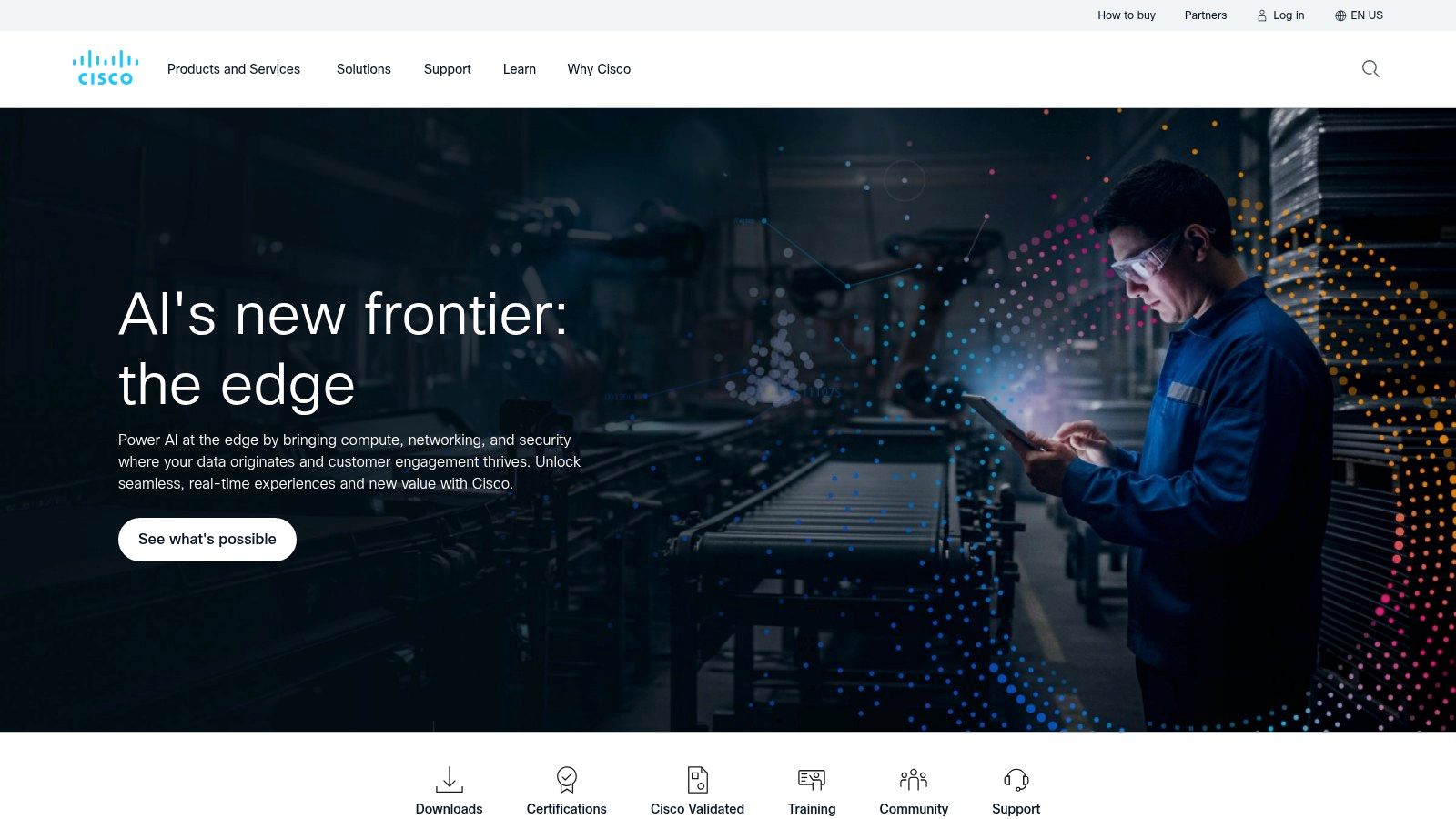
The platform's strength lies in the deep integration across its offerings, all powered by Cisco Talos, one of the world's largest commercial threat intelligence teams. Features like Secure Access deliver modern Zero Trust Network Access (ZTNA) and Secure Web Gateway (SWG) capabilities, crucial for ethical risk management in today's distributed workforces. Enterprises can explore these capabilities through self-guided demos and trial flows directly from the website, allowing for hands-on evaluation before committing.
However, the breadth of the portfolio can introduce complexity in selecting and deploying the right mix of solutions. Pricing is typically not transparent and requires engagement with sales or a partner, which can slow down procurement. Despite this, for organizations needing one of the best enterprise security software suites from a single, trusted vendor, Cisco Secure provides a robust and interconnected ecosystem that simplifies security operations and enhances threat visibility.
Key Features & Offerings:
Integrated Security Suite: Includes endpoint protection (Secure Endpoint), DNS/web security (Umbrella), zero trust access (Duo), and a unified XDR platform.
Talos Threat Intelligence: Industry-leading threat intelligence is natively integrated across the entire product portfolio for proactive defense.
Zero Trust and SASE: Modern security frameworks are supported through Secure Access, which combines ZTNA, SWG, and other SASE components.
Flexible Evaluation: Offers self-guided tours and free trials for many of its products, enabling thorough pre-purchase assessment.
9. Fortinet (FortiGate/FortiEDR/FortiSASE)
For enterprises requiring a unified security architecture that spans from the network edge to the cloud, Fortinet’s Security Fabric offers a comprehensive suite of integrated solutions. Centered around its FortiGate Next-Generation Firewalls (NGFWs), the platform consolidates security functions like endpoint protection (FortiEDR) and Secure Access Service Edge (SASE) into a single, manageable ecosystem. This approach is highly effective for organizations seeking to reduce vendor sprawl and streamline security operations across distributed environments.

The platform's strength lies in its ability to provide consistent security policies and visibility, whether on-premises, in a data center, or across multiple clouds. Fortinet’s wide range of hardware and virtual appliances allows for flexible deployment tailored to specific performance needs, from small branch offices to large corporate headquarters. This integrated fabric simplifies the management of complex security challenges, including the mitigation of internal threats, by ensuring that endpoint, network, and cloud security tools communicate and respond cohesively.
However, a primary consideration for procurement teams is that official pricing is quote-based and typically handled through a network of authorized partners and resellers. This means price estimates can vary, requiring diligence in the vendor selection process. Additionally, hardware lead times can fluctuate depending on the specific model and global supply chain conditions. Despite these factors, its consolidated platform makes Fortinet a powerful choice for organizations building a robust and integrated enterprise security software posture.
Key Features & Offerings:
Integrated Security Fabric: A unified platform combining NGFW, endpoint (EDR), SASE, and other security services for cohesive threat management.
Wide Range of Appliances: Extensive portfolio of hardware and virtual NGFWs to fit diverse performance and deployment requirements.
Centralized Management: FortiManager and FortiAnalyzer provide single-pane-of-glass visibility and control across the entire security infrastructure.
Partner-Led Procurement: A global network of resellers and partners facilitates procurement, implementation, and support services.
Website: https://www.fortinet.com
10. Okta (Workforce Identity Cloud)
Okta's Workforce Identity Cloud is a cornerstone platform for enterprises seeking to secure access and manage user lifecycles across countless applications. It centralizes identity management, providing robust Single Sign-On (SSO) and Multi-Factor Authentication (MFA) to protect against unauthorized access, a critical component in mitigating human-factor risk. By simplifying how users connect to technology, Okta helps security teams enforce consistent policies and reduce the attack surface associated with credential theft.

The platform excels with its mature ecosystem and extensive integration catalog, making it one of the best enterprise security software choices for unifying disparate IT environments. Its refined admin experience allows for granular control over user permissions and access policies, which is vital for maintaining a strong compliance and risk management framework. Okta's transparent, per-user pricing for entry-tier plans and available free trials enable teams to evaluate the solution's core functionality before committing to a larger deployment.
However, organizations must be mindful that advanced features like privileged access management and adaptive MFA are often reserved for higher-priced tiers or require direct engagement with sales. While the per-user model is predictable, costs can scale significantly for large enterprises that need multiple advanced modules. Despite this, Okta’s proven reliability and central role in a zero-trust architecture make it an essential tool for protecting corporate assets and streamlining user access securely.
Key Features & Offerings:
Unified Access Management: Provides Single Sign-On (SSO), Multi-Factor Authentication (MFA), and Adaptive MFA.
Lifecycle Management: Automates user onboarding, offboarding, and permission changes across integrated applications.
Extensive Integration Network: Offers thousands of pre-built connectors for cloud and on-premise applications.
Transparent Starter Tiers: Published per-user pricing and free trials for foundational identity and access management needs.
Website: https://www.okta.com
11. Zscaler (Zero Trust Exchange)
For enterprises shifting to a distributed workforce, Zscaler's Zero Trust Exchange offers a cloud-native platform designed to securely connect users, devices, and applications regardless of location. This SASE (Secure Access Service Edge) framework moves security from the traditional network perimeter to the cloud, directly addressing the human-factor risks associated with remote and branch office access. By enforcing a strict zero-trust policy, it ensures no user or application is inherently trusted, significantly strengthening the posture against internal threats and external breaches.

The platform stands out by replacing legacy VPNs and firewalls with a unified, policy-driven architecture that inspects all traffic. This approach is central to its effectiveness as one of the best enterprise security software solutions for modern IT environments. Features like Zscaler Private Access (ZPA) provide segmented, application-level access instead of network-level access, minimizing the attack surface and preventing lateral movement. This granular control is vital for ethical risk management, allowing organizations to protect critical data without intrusive employee monitoring.
However, a primary consideration is the pricing model, which is not transparent on the website and requires direct engagement with the sales team. Quotes vary based on user volume and the specific bundles or add-ons selected, which can complicate initial budgeting. Despite this, its comprehensive suite of integrated tools for threat protection, data loss prevention, and digital experience monitoring makes Zscaler a powerful choice for organizations committed to a true zero-trust security model.
Key Features & Offerings:
Zero Trust Private Access (ZPA): Provides secure, direct access to private applications without placing users on the corporate network.
Secure Internet Access (SIA): Includes a cloud-native firewall, secure web gateway, and sandboxing to protect users from web-based threats.
Broad Add-On Ecosystem: Offers extensions for data protection, cloud security posture management (CSPM), and digital experience monitoring.
Unified Policy Engine: Centralizes policy management for all users and locations, ensuring consistent security and access controls.
Website: https://www.zscaler.com
12. CDW (reseller and solution provider)
For enterprises seeking a consolidated procurement partner for a wide array of security technologies, CDW offers a comprehensive one-stop-shop experience. As a major IT solutions provider, it simplifies the acquisition of the best enterprise security software from leading brands like Cisco, CrowdStrike, and Palo Alto. This model is ideal for organizations that need to procure and deploy diverse solutions, from network security to ethical risk management tools, without managing dozens of separate vendor relationships.
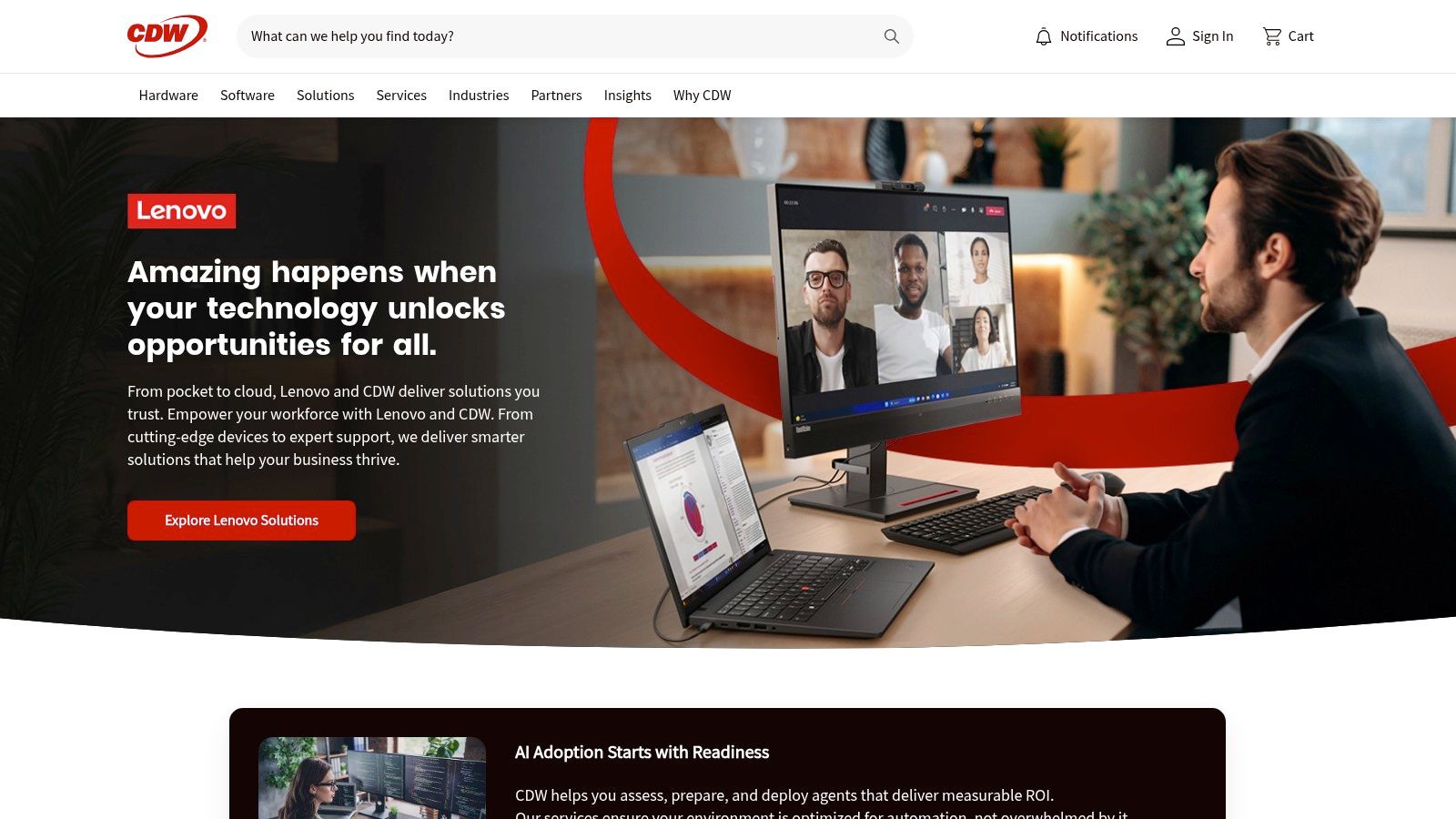
CDW excels by combining its extensive software catalog with dedicated account management and professional services. This allows enterprises to not only purchase licenses but also get expert support for solution design, implementation, and ongoing management, which is critical when addressing complex internal threats. The platform supports enterprise-grade procurement processes, including custom quotes, bulk ordering, and contract pricing, making it a reliable fulfillment partner for both corporate and public sector entities.
However, a key consideration is that the list prices displayed on the website may not reflect the final negotiated rates for large organizations, requiring direct engagement for an accurate quote. Furthermore, not all enterprise-specific SKUs are publicly listed with pricing. Despite this, CDW’s ability to streamline multi-vendor procurement and provide integrated support services makes it a strategic asset for efficiently building a robust, multi-layered security posture that is fully EPPA-compliant.
Key Features & Offerings:
Comprehensive Security Catalog: A vast selection of hardware and software from hundreds of top-tier security vendors.
Enterprise Procurement Support: Facilitates custom quotes, contract pricing, bulk orders, and specialized public sector channels.
Professional & Managed Services: Offers expert consultation for solution design, implementation, and ongoing security management.
Centralized Account Management: Provides a single point of contact for sourcing diverse technologies, simplifying vendor management.
Website: https://www.cdw.com
Top 12 Enterprise Security Software Comparison
Product | Core focus & unique features ✨ | Target audience 👥 | Trust & compliance & quality ★ | Pricing & procurement 💰 |
|---|---|---|---|---|
Logical Commander Software Ltd. 🏆 | Proactive, non‑invasive AI internal‑risk platform (Risk‑HR, EmoRisk, SafeSpeak); EPPA‑compliant ✨ | 👥 HR / Compliance / Security / Legal / Execs | ★★★★★ ISO27001/27701, GDPR/CPRA, E2E encryption, anonymization | 💰 Free trial (no CC); enterprise quotes; immediate ROI |
AWS Marketplace | Centralized procurement for security SaaS; Vendor Insights & billing integration ✨ | 👥 Cloud procurement, security ops, finance | ★★★★ Vendor profiles & continuous compliance evidence | 💰 PAYG / annual / private offers; vendor quotes possible |
Microsoft Azure Marketplace (Security) | Curated security catalog + private offers & tenant governance ✨ | 👥 Azure tenants, SecOps, procurement | ★★★★ Native Azure integration, governance tools | 💰 SaaS/pay‑as‑you‑go / private offers; quote‑based |
Google Cloud Marketplace + SCC | Deploy to GCP + Security Command Center for posture & detections ✨ | 👥 GCP users, multi‑cloud SecOps | ★★★★ SCC integrations (Standard→Enterprise) | 💰 One bill via Google; some SKUs require sales |
CrowdStrike (Falcon) | Cloud EDR/XDR, threat intel, modular add‑ons; quick trials ✨ | 👥 SOCs, endpoints teams, MDR buyers | ★★★★★ Strong analyst reputation; fast trials | 💰 Per‑device bundles, posted pricing for select packs; enterprise quotes |
SentinelOne (Singularity) | AI‑driven EDR/XDR, Flex consumption licensing, retention options ✨ | 👥 Endpoint/SecOps teams, MSSPs | ★★★★ Clear tiered web pricing; automation features | 💰 Published per‑endpoint tiers; Flex usage pricing |
Palo Alto Networks | Full‑stack (Cortex, Prisma, Strata) for NGFW, XDR, cloud security ✨ | 👥 Enterprise networks, cloud/SOC teams | ★★★★ Mature platform; enterprise deployments | 💰 Quote‑based for many products; complex licensing |
Cisco Secure | Endpoint, Duo (ZT), Umbrella, XDR with Talos threat intel ✨ | 👥 Large enterprises, network/SOC teams | ★★★★ Talos‑backed detections; broad portfolio | 💰 Tiered licensing; sales/partner quotes typical |
Fortinet | FortiGate/FortiEDR/FortiSASE across hardware & virtual appliances ✨ | 👥 Campus/branch, data center, MSPs | ★★★ Consolidated Fabric; broad model range | 💰 Quote‑based; partner/reseller procurement |
Okta (Workforce Identity) | SSO, MFA, lifecycle, PAM with published entry pricing ✨ | 👥 IT, identity teams, HR | ★★★★ Mature identity ecosystem; integrations | 💰 Published entry‑tier per‑user pricing; trials |
Zscaler (Zero Trust Exchange) | SSE/SASE, ZPA, DLP, deception & digital experience ✨ | 👥 Remote/branch users, security architects | ★★★★ Strong zero‑trust posture, training programs | 💰 Bundle quotes; pricing varies by volume/features |
CDW (reseller & services) | One‑stop procurement, quoting, implementation & managed services ✨ | 👥 Procurement teams, large buyers, public sector | ★★★★ Broad vendor catalog; enterprise support | 💰 Quote & contract pricing; negotiated rates available |
Choosing Your Proactive Defense: The New Standard in Enterprise Security
Navigating the crowded market for the best enterprise security software can be a formidable task. As we've explored, the landscape is diverse, spanning from comprehensive cloud marketplaces like AWS and Azure to specialized endpoint protection from CrowdStrike and SentinelOne, and foundational network security from giants like Palo Alto Networks and Cisco. Each of these solutions offers a critical layer of defense against external cyber threats, forming the bedrock of a modern enterprise security posture. They are essential for protecting data, infrastructure, and access points from an ever-growing array of sophisticated attacks.
However, a critical analysis of these tools reveals a common blind spot: the human factor. While platforms like Okta secure identities and Zscaler enforces zero-trust architecture, their focus remains primarily on access control and external threat vectors. The traditional security model is built to react to breaches, investigate incidents after they occur, and plug holes once damage has already been done. This reactive approach, while necessary, is no longer sufficient. It is a costly, resource-intensive cycle that fails to address the root cause of many significant organizational risks: internal threats originating from human behavior, whether intentional or accidental. Relying solely on these tools leaves a significant gap in an organization's governance, risk, and compliance framework.
Shifting from Reaction to Prevention
The true evolution in enterprise security lies in supplementing this defensive cyber stack with a proactive, ethical, and non-intrusive layer focused on internal risk. This is where a clear distinction must be made. The new standard is not about surveillance, employee monitoring, or other invasive techniques that erode trust and create legal liabilities under regulations like the EPPA. Instead, it’s about understanding and mitigating human-factor risk before it escalates into a full-blown incident. This requires a different class of tool altogether, one designed for prevention rather than forensic investigation.
Solutions like Logical Commander's AI-driven platform exemplify this forward-thinking approach. By focusing on ethical risk assessment, it provides leadership, from the Chief Risk Officer to HR and legal departments, with the insights needed to prevent issues like fraud, data exfiltration, and compliance breaches. This preventive stance is the missing piece in most enterprise security strategies. It complements your existing cybersecurity investments by addressing the vulnerabilities that firewalls and endpoint detection cannot see, strengthening your overall defense from the inside out.
Actionable Steps for a Resilient Security Strategy
To build a truly comprehensive security framework, you must integrate both external and internal defenses. Here are your next steps:
Audit Your Current Stack: Evaluate your existing tools. Where are the gaps? Are you overly reliant on reactive measures? Identify areas where human-factor risks are not being adequately addressed.
Define a Proactive Strategy: Shift your organizational mindset from "incident response" to "risk prevention." Document your goals for mitigating internal threats and establish clear, ethical guidelines for any new platform you adopt. To structure this crucial step, you may find it helpful to consult resources like cybersecurity proposal templates to streamline your planning and internal communication.
Prioritize EPPA-Compliant Solutions: When evaluating tools for internal risk management, ensure they are fully aligned with regulations like the Employee Polygraph Protection Act. Reject any solution that relies on surveillance, lie detection, or other legally risky and ethically questionable methods.
Integrate, Don't Just Add: The goal is not just to acquire more software, but to create a cohesive ecosystem. The best enterprise security software strategy ensures your internal risk platform works in concert with your HR, compliance, and cybersecurity functions to provide a holistic view of organizational resilience.
Ultimately, protecting your enterprise is no longer just about building higher walls. It's about cultivating a secure and ethical internal environment where risks are identified and neutralized before they can cause harm. By embracing a proactive, AI-driven, and ethically grounded approach to internal threats, you not only protect your assets and reputation but also build a stronger, more resilient organization ready for the challenges of tomorrow.
The landscape of enterprise security has evolved beyond traditional defenses, leaving a critical gap in managing human-factor risk. Logical Commander Software Ltd. delivers the new standard in proactive, ethical, and EPPA-aligned internal risk prevention, addressing the threats that conventional cybersecurity tools miss. Don't wait for the next incident—prevent it.
Get Platform Access: Start your free trial today
See it in Action: Request a personalized demo
Become an Ally: Join our PartnerLC ecosystem
Deploy at Scale: Contact our enterprise team
%20(2)_edited.png)
